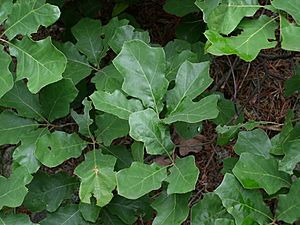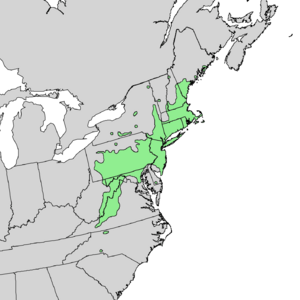Bear oak facts for kids
Quick facts for kids Bear oak |
|
|---|---|
 |
|
| Quercus ilicifolia on North Fork Mountain, West Virginia, USA. | |
| Conservation status | |
| Scientific classification | |
| Genus: |
Quercus
|
| Species: |
ilicifolia
|
 |
|
| Natural range | |
| Synonyms | |
|
List
Quercus banisteri Michx.
Quercus discolor var. banisteri (Michx.) Spach Quercus ilicifolia var. georgiana A.Wood Quercus nana (Marshall) Sarg. 1895 not Willd. 1805 Quercus nigra var. ilicifolia Kuntze Quercus nigra var. pumila Marshall Quercus pumila Sudw. 1898 not Walter 1788 Quercus rubra var. nana Marshall |
|
Quercus ilicifolia, commonly called bear oak or scrub oak, is a small, bushy oak tree. It grows in the eastern United States and southeastern Canada. You can find it from Maine to North Carolina. There are also some populations in Ontario, Canada. The name ilicifolia means "holly-leaved." This is because its leaves look a bit like holly leaves.
Contents
What Does Bear Oak Look Like?
Bear oak is usually a small shrub. Sometimes, it can grow up to 6 meters (20 feet) tall. It often forms thick, dense patches called "thickets." These thickets can be hard to walk through.
Roots and Stems
This plant grows from a very large taproot. This root can be as thick as 20 centimeters (8 inches). The taproot lives for a long time. It can produce many new stems above the ground over the years.
Leaves and Flowers
The leaves of the bear oak are arranged alternately along the stem. Each leaf can be up to 15 centimeters (6 inches) long. They can also be up to 10 centimeters (4 inches) wide. Bear oak plants have both male and female flowers. The male flowers grow in long clusters called catkins. The female flowers are smaller and grow alone or in small groups.
Acorns and Reproduction
The acorns are egg-shaped. They are about 1 to 2 centimeters (0.4-0.8 inch) long. They have a cap that looks like a saucer. Bear oak can reproduce in two ways. It can grow from seeds found in its acorns. It can also grow new stems from its roots. This is called vegetative reproduction.
Where Does Bear Oak Grow?
Bear oak is a very common plant in many places. It grows in different types of habitats. In Maine, you might find it in forests. It grows there with red maple (Acer rubrum) and gray birch (Betula populifolia). It also grows with quaking aspen (Populus tremuloides).
Specific Habitats
In Massachusetts, bear oak grows on shrublands. It shares these areas with black huckleberry. You can find it on Nantucket and Martha's Vineyard. On Cape Cod, it grows with pitch pine (Pinus rigida). It also grows with broom crowberry.
Fire-Adapted Plant
Bear oak is common in the Pine Barrens of New Jersey. It also grows in similar areas on Long Island. This oak is very good at surviving wildfires. It doesn't like shade. It needs fires to clear away other plants. This way, it can get enough sunlight. After a fire, new stems grow quickly from its roots.
Why Is Bear Oak Important?
Bear oak provides food and shelter for many animals. Its acorns are a key food source.
Food for Animals
- Bears: Bears eat the bitter acorns. They especially like them before they go into hibernation.
- Deer: White-tailed deer eat the acorns, stems, and leaves.
- Squirrels: Many types of squirrels collect and hide the acorns. This is called caching.
- Birds: Many birds depend on bear oak acorns. Wild turkeys prefer them over other foods.
Home for Insects
A large number of insect species live on the bear oak. This oak is a main food plant for many rare insects. This includes 29% of the rare or endangered Lepidoptera (butterflies and moths) in southern New England and southeastern New York.
Other Uses and Locations
Bear oak has been used in projects to bring plants back to an area. For example, it was used at the Fresh Kills Landfill on Staten Island. This was a large landfill that is now being turned into a park.
In the Piedmont region of North Carolina, bear oak grows on rocky hilltops. It is listed as a State Endangered Plant there. This means it is a protected species in that state.
See also
 In Spanish: Quercus ilicifolia para niños
In Spanish: Quercus ilicifolia para niños


